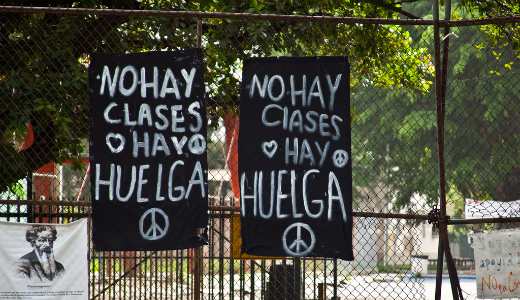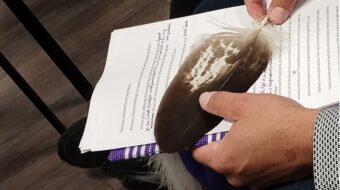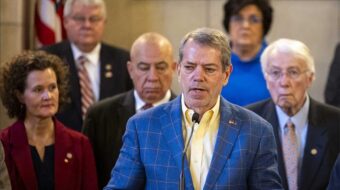
Pepper spray and clubs were the methods used by police in Puerto Rico against protesting students at the University of Puerto Rico’s main campus at Rio Piedras near San Juan on Wednesday, Feb. 9. But the students are getting more support from the general public and show no sign of giving in.
The current series of protests began in April of 2010, when the administration of the right-wing governor, Luis Fortuño of the New Progressive Party (PNP), finding itself faced with a major budget crunch, proposed a sharp cut in the budget for the university system. This cut was to be paid for by increasing registration fees per student by $800 and implementing severe program cuts. Students at Rio Piedras and several others of the 11 campuses reacted angrily. They charge that these measures will force up to 10,000 students out of the university, as well as damage some of its most prestigious programs.
Consequently, they have been carrying out a series of militant but peaceful demonstrations.
The cuts in the university programs and the rise in fees is part of a right-wing assault by the Fortuño administration in which thousands of public workers have also been laid off and their union contracts cancelled.
Again in December 2010, there were clashes between protestors and police, as students struck in anticipation of the implementation of the $800 fee in the coming session. On that occasion, there was a sharp reaction by the police. On Thursday Jan. 27, students marched to the capitol building in San Juan, and were subjected to a police attack in which, according to observers, pressure holds amounting to torture were employed by police. In addition, female students were sexually molested. They marched again on Feb. 7. Police were waiting for them, but were deflected from attack by a mass mobilization of non-students, including professors, non-teaching personnel and other members of society who interposed themselves between the police and the students, preventing what could have been an ugly clash with possible injuries.
On Feb. 9, two days after classes resumed, students massed again to protest on the Rio Piedras campus, but were confronted once more by police on horseback and on foot, who used pepper spray and clubs to attack students who were demonstrating and painting protest slogans on the sidewalk. Many students, including student leader Adriana Mulero, were arrested, bringing the number arrested this year to over 150.
After Wednesday’s arrests, the Puerto Rican Association of University Professors announced that it was staging a 24-hour strike to protest the police presence on campus and the mistreatment of the students. The union representing the university’s non-teaching employees, the Brotherhood of Exempt non-Teaching Employees, is also participating. Important sectors of labor and other social sectors continue to be supportive of the students. On Feb. 5, a resolution was presented to the Chamber of Deputies by four women members, who called for an investigation of police abuse of the students. Students and their allies are also angry with the University of Puerto Rico administration for its hostile attitude and for facilitating the presence of police on campus.
Meanwhile, one of several pro-independence groups, the Puerto Rican Nationalist Party, charges that persecution of its members by U.S. authorities is on the uptick with searches of members’ homes and phone taps by the U.S. Department of Homeland Security. National Party Chairman Francisco Torres claims that on his recent return from Spain via New York City, he and his wife were arrested for several hours without cause.
Puerto Rico, originally a Spanish colony, was seized by the United States in the so-called “Spanish American War” of 1898, and never given independence. It is currently ruled as an “Associated Free Territory” or “Commonwealth” of the United States, but is seen as a colony by many in Puerto Rico and beyond. Over the years, there have been frequent clashes, some armed, between supporters of independence and U.S. and local authorities. During part of the 1940s, the U.S.-installed authorities made it illegal to advocate independence for the island, or even fly the Puerto Rican national flag or sing patriotic Puerto Rican songs. Though this “gag law” (Ley de Mordaza) is no longer in force, complaints of police spying on and harassment of the opposition are a continuous feature of life on this island, and of members of the numerous Puerto Rican communities in the United States.
Image: Aaron Goodman // CC BY-ND 2.0

MOST POPULAR TODAY


Zionist organizations leading campaign to stop ceasefire resolutions in D.C. area

High Court essentially bans demonstrations, freedom of assembly in Deep South

Afghanistan’s socialist years: The promising future killed off by U.S. imperialism

Communist Karol Cariola elected president of Chile’s legislature






Comments